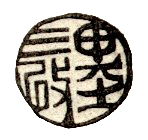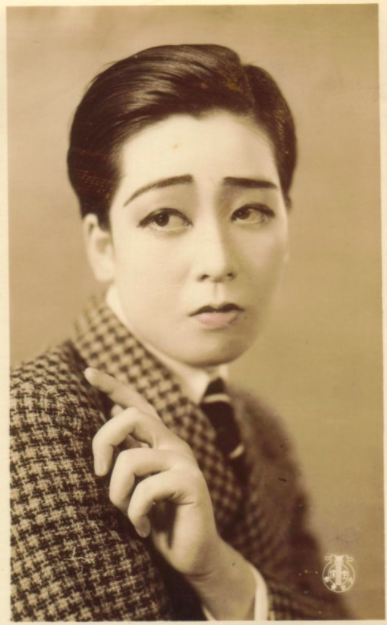Golden Age Otokoyaku
Ashihara Kuniko and the Golden Age
The standard structure of the theater emerged in the 1930s and continues to be the organization of the theater today. Trainees studied for approximately two years at the academy before making their debut in one of the theater’s troupes. By the end of the 1930s, the Revue was divided into four performance troupes: Flower (Hana-gumi), Moon (Tsuki-gumi), Snow (Yuki-gumi), and Star (Hoshi-gumi.)[1] These troupes would perform all their productions together and had a star otokoyaku (male role performer) and musumeyaku (female role performer) couple playing the leads. The otokoyaku and musumeyaku (Figure 16) were official positions that actresses were assigned during their time in the academy and would stay with for the rest of their careers. This was the theater configuration when Ashihara Kuniko made her debut and quickly rose to popularity.
Ashihara Kuniko was born Okamoto Eiko in 1912 in Hyogo prefecture. She attended Takarazuka music school in 1928 and made her debut the following year. She began her career as a member of the Flower troupe, then moved to the Star troupe, and finally to the Snow troupe. She participated in approximately thirty shows between 1929 and 1939.[2] In her decade at Takarazuka, Ashihara generated a substantial visual footprint. This is the decade where the character of the revue known today would begin to form, particularly in the case of the otokoyaku.[3] Ashihara’s generation, well represented in this group photo from the first half of the 1930s (Figure 17), ushered in a series of firsts as the first official class of otokoyaku. Short hair was the most notable of their visual innovations, which became the most potent signifier of role assignment in later generations.[4] They also fully adopted the appearance of the clean-cut dandy, mirroring the style of Hollywood stars like Rudolph Valentino and Clark Gable. Ashihara Kuniko, sitting third from the right on the bottom row, later became one of the most popular among them.
Particularly noteworthy among the plethora of Ashihara’s images are those from Unforgettable Song in 1938. This show is an excellent example because it has more surviving material and occurs late in Ashihara’s career when her style is fully matured. It was also the year she married the illustrator Nakahara Junichi and the artistic relationship between his work and her stage craft became central.
The Visual Culture of Unforgettable Song
Unforgettable Song, an original Takarazuka production, is the story of Jane, the niece of Duke Meldrum. She becomes secretly engaged to a Scottish painter named Darmen (played by Ashihara). However, rumors that Darmen is in love with an opera singer named Melva ruin their relationship, and the two go their separate ways. Darmen goes to the front lines during the war, and Jane becomes a nurse. In the war, Darmen is injured and becomes blind. When Jane hears about Darmen’s fate, she secretly takes a job as his nurse to serve as his eyes. Jane shares the story of her lost love with Darmen, and he encourages her to write to her former fiancé. Moved by him, Jane plays a song on the piano that lets Darmen know who she is. With this, the two finally reunite.
The first Image from the promotional material is a bromide of Ashihara in one of her costumes (Figure 18). Ashihara is pictured in headshot format, dressed in a checkered houndstooth suit jacket. She is sporting the signature short slicked-back hair of the 1930s otokoyaku. While these features lend themselves to the male role she plays, the reading of her appearance becomes more complex when the viewer looks at her facial features and pose. Ashihara’s gaze goes up to the side; her lips are delicately drawn, Ashihara slightly pinches her mouth closed to make it look small and accentuate the pout created by the sharp cupid’s bow and rounded lower lip in the make-up. This slight pout and her long, downward drawn eyebrows make a feminine, sentimental expression. She tilts her head and rests her hand near her shoulder, increasing the sentimentality with a delicate pose. These characteristics, which reveal Ashihara’s femininity, seem to work against her casting as the male lead of the play. They also create a visual dissonance with her decidedly masculine styling.
In the program cover for Unforgettable Song (Figure 19), Ashihara poses differently; now, looking down, her expression reads less dreamy and demurer. Still present are the long sentimental eyebrows and perfectly shaped lips. But her pale skin, rosy cheeks, and red lips are now over-emphasized, adding a heightened sense of femininity. Ashihara is the male lead of a melodramatic romance, but in this illustration, she is reminiscent of a blushing schoolgirl. A lack of direct eye contact and flushed cheeks communicate a shy, submissive character, attributes traditionally valued in women but not necessarily in a leading man. The indirect gaze in the illustration could also be in consideration of the character who is blind since fully closed or half-closed eyes were a conventional way to communicate this aspect of the character. The final image is a stage shot featured in Graph magazine, a Takarazuka publication, to promote the show to its readers (Figure 20). Ashihara (on the right) is alongside Sakura Hisako, the musumeyaku playing Jane. There is almost no differentiation in the makeup between the two actresses. At the same time, while their costumes indicate their roles, they have similar appearances. The conventions of Takarazuka makeup, like all theatrical makeup, serve a practical purpose. Enlarging features like eyes and eyebrows and defining the mouth make the actress’s face easier to read in a large theater. The audience can then better experience the emotions of the characters. In the case of Takarazuka, these desired aesthetics arise from the interaction of two critical phenomena that were taking shape in the 1920s and 30s: gender ambivalence and shojo (teenage girl) culture. These two phenomena are essential to our understanding of how Ashihara comes to embody Takarazuka’s ideal “man” through the implementation and manipulation of both phenomena in her portraits.
[1] Moon, Flower, and Snow all existed before 1930 and Star troupe would be added over the course of the decade. The fifth troupe that exists today, Cosmos (Sora-gumi), would not be formed until the 1990s, making it the youngest troupe in the theater. The troupes are sometimes associated with certain specialties. For instance, the Snow troupe is the best at Nihonmono productions. But each troupe’s specialty has shifted throughout the decades as the theater has adopted new shows and theatrical styles.
[2] Ashihara retired in 1940. In the postwar years, she acted in musicals and straight plays with the Imperial Opera theater and worked in TV dramas and movies. In all these post Takarazuka roles she played female characters.
[3] This decade is acknowledged as the golden age of the theater because it was so formative for Takarazuka’s current identity, calling it the golden age is not meant to imply later decades declined. Every subsequent decade of Takarazuka would produce its own innovations and noteworthy stars.
[4] Leonie R. Stickland, Gender Gymnastics: Performing and Consuming Japan’s Takarazuka Revue (Melbourne: Transpacific Press, 2008,) 117.






